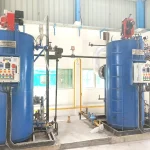WET SCRUBBER
WET SCRUBBER
Wet scrubbers are air pollution control devices that remove pollutants from exhaust gas streams by capturing them in water. They are used in industries to control particulate matter and gaseous emissions, from the combustion process in boilers.
The scrubbing process involves passing the polluted gas stream through the water where contaminants are absorbed or trapped as the gas makes contact with the liquid droplets. Wet scrubbers are effective for removing fine particulate matter.
We manufacture Impinging Plate scrubbers, where flue gas passes through a series of plates, where water is sprayed onto the plates. The impingement forces particles to collide with the liquid, trapping them. All the pollutants trapped in water are flushed out and the treated flue gas passes through the chimney, resulting in treated gas being released in the environment.


